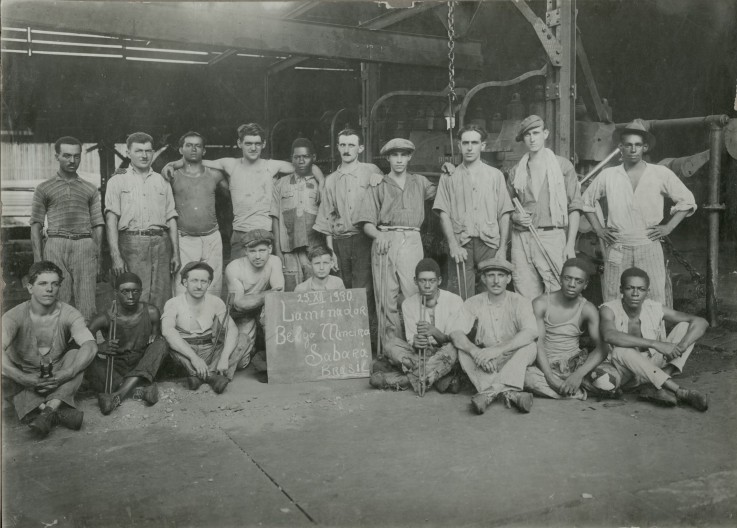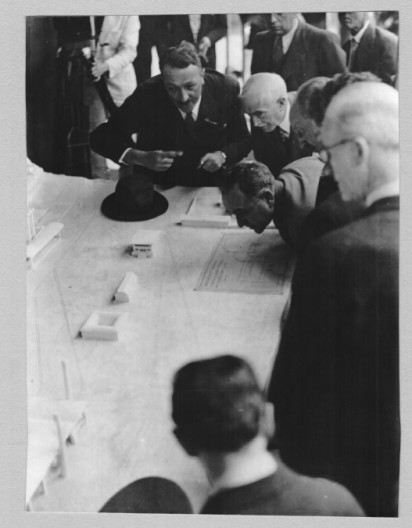ARBED (Aciéries réunies de Burbach-Eich-Dudelange), a steel conglomerate established in 1911, rapidly became the embodiment of Luxembourg’s economic and social prosperity at the beginning of the 20th century. In 1921, ten years after the conglomerate was founded, ARBED’s leaders established a subsidiary company, the Companhia Siderúrgica Belgo-Mineira, in the Brazilian state of Minas Gerais. Belgo-Mineira rapidly became the largest steel producer in Latin America but its history in Luxembourg remains largely unknown.
Almost a century later, Luxembourg’s Minister of Foreign and European affairs, Jean Asselborn, officially inaugurated the Luxembourg Embassy in Brasília, the federal capital of Brazil, on 1 March 2018. Asselborn commented that the inauguration of the Embassy, the first of its kind on the Latin American continent, not only highlighted the tenacious diplomatic ties between the two countries but also demonstrated the “solid and strong relationship between our two nations”.1 Asselborn pointed out that this relationship was partly established a century ago, through the creation of ARBED’s subsidiary iron-producing company, the Companhia Siderúrgica Belgo-Mineira:
I also see among us the descendants of Luxembourg engineers and technicians, who brought their expertise and helped build Brazil’s steel industry, thereby contributing to this country’s economic development, from the 1920s. Indeed, Luxembourg’s steel giant ARBED, now ArcelorMittal, has from those early days been a great investor in Belgomineira, which has become a major player in Latin America under Luxembourg leadership.2
- 1. Jean Asselborn at the inauguration of the Luxembourg Embassy in Brasília. “Lëtzebuerger Ambassade a Südamerika ageweit”, RTL, http://www.rtl.lu/letzebuerg/archiv/1143169.html (accessed 5 March 2018).
- 2. Ibid.
Indeed, Luxembourg’s role in the development of the Brazilian steel industry might be the country’s most significant achievement outside Europe in the first half of the 20th century, although it is still largely neglected in European research. While academics have not tended to focus on Belgo-Mineira, other figures have pondered on the links between the two countries: Marc André Meyers, a Brazilian author of Luxembourg origin, explored the imaginary and fictional connections between Luxembourg and Brazil in his novel “D’amour et d’acier”, published three years ago. Meyers’ novel was the last published work about Belgo-Mineira in Luxembourg. My own objective, therefore, is to fill this gap in academic contributions about the history of Luxembourg’s expansion to Brazil and its underlying after-effects.1
One might wonder how I came to work on this project in the first place. In the autumn of 2015, which also marked the end of my first year as a PhD candidate, as our FAMOSO-2 project was further unfolding, I started to read about ARBED’s global expansion.2 I knew that ARBED had set up a subsidiary company in the Brazilian state of Minas Gerais, but other than that I could not find any more detailed information. Curiosity, seasoned with a dose of intrigue and a desire to find out whether Belgo-Mineira was as influential in Minas Gerais as ARBED was in Luxembourg, coincided with the “semester abroad” programme created by the University of Luxembourg’s Doctoral School, taking me 10,000 kilometres away from the Belval office, all the way to Brazil. The initial plan was to learn how Brazilian scholars write history, work my way through my host university and at the same time find out some more information about Belgo-Mineira. “It could be a good paper,” I thought.
Less than a month into my Brazilian adventure, I discovered a historian’s treasure trove: an entire archive dedicated to the history of Belgo-Mineira. The archive, now named “Centro de Memoria da ArcelorMittal Brasil”, was set up in the colonial city of Sabará, in Minas Gerais. The archive was compiled in the year 2000 with the aim of disseminating knowledge about the development of Belgo-Mineira, preserving locally produced knowledge and providing access to information.3 Thanks to the very helpful historian and archivist Isabella Menezes, I was able to collect a substantial amount of textual and audiovisual material, and I came back to Luxembourg with six kilograms of extra weight in my luggage and several gigabytes added to my hard drive. Excited about my new discoveries and impressed by the extent of Belgo-Mineira’s economic and social activities, I knew that I could no longer transform all the information into a single paper. Instead, I expanded the focus of my thesis from ARBED’s social initiatives in Luxembourg to its social involvement in Brazil. Once I got stuck into my research about Belgo-Mineira, I realised that part of the picture was missing: the only documents I had belonged to the archive provided by the company itself. I was determined to find other primary sources. In the Luxembourg National Archives, as I discovered very early on in my research, documents about Belgo-Mineira are very scarce, so it was necessary to look elsewhere. After extensive internet browsing, I finally came across the Juiz de Fora University Archives, compiled by Professor Galba Di Mambro, who kindly granted me access to all the documents he had collected decades ago. I am immensely grateful for his kind help and interest in my research and happy that we are still in touch and exchanging thoughts and opinions. Professor Di Mambro himself started researching Belgo-Mineira in the early 1980s. For this reason, he travelled to Luxembourg and managed to gather a significant number of documents extending as far back as the early 1920s. To my knowledge, many of these Luxembourg documents, or more accurately their copies, only exist in the Juiz de Fora Archive which Di Mambro carefully categorised and stored. We might give a little thought here to the curious trajectory of these documents, which travelled to Brazil, disappeared from Luxembourg, were difficult to trace and have finally come back to their country of origin several decades later. It could be a study of circulations, connections and flows on its own, as Saunier explained so well in his Transnational history.4 In my study, Di Mambro’s archive, in combination with the documents from Centro de Memoria in Sabará, numerous visual sources such as photographs and films, interviews and newspaper articles, opened an entire universe of information to be explored. My concept of corpornation was born and my PhD project is now taking its final shape under the following title:
Steel and Iron Corpornations and the Emergence of Modern Welfare in Luxembourg and Minas Gerais (c. 1910-1960)
So how did Luxembourg’s steel industry expand to Brazil and what changes occurred with that expansion? What do I mean by “corpornation”?
Luxembourg’s exit from the economic union with Germany, the Zollverein, in 1918 put the country’s industrialists in a difficult position in the post-war years. While Luxembourg tried to open up new export markets by launching a sales company called Columeta (Comptoir Luxembourgeois de Métallurgie) in 1920, it still largely depended on exports to Germany.5 Since Luxembourg could no longer place its steel products on the German market, the two founders of Luxembourg’s biggest steel conglomerate ARBED, Émile Mayrisch (1862–1928) and Gaston Barbanson (1876–1946), began to search for new export markets. Two markets turned out to be favourable for ARBED’s expansion: India and Japan in Asia, and Argentina and Brazil in Latin America. Émile Mayrisch and Gaston Barbanson therefore decided, as early as 1920, to explore the possibilities of establishing a subsidiary company in the Brazilian state of Minas Gerais. As well as the fact that this state had an abundance of high-quality resources, the political representatives of Minas Gerais and Brazil were strong proponents of industrial development. These two factors simplified ARBED’s expansion to Brazil. The existence of a small steel company called Companhia Siderúrgica Mineira further facilitated the establishment of ARBED’s subsidiary, and by significantly increasing the capital of the existing company, Companhia Siderúrgica Belgo-Mineira was established on 11 December 1921 in the city of Sabará, in Minas Gerais. While ARBED’s leaders had a clear initial idea of how to develop the iron and steel industry in Brazil, namely to increase production in Sabará until a new, modern steel plant could be built from scratch in the town of João Monlevade, they did not expect to be confronted with so many difficulties. The soil in Minas Gerais was rich in iron, but the human and technical support was almost non-existent. Moreover, Brazilian engineers had no knowledge or equipment to mine the iron ore, and Brazil also lacked a qualified workforce. The initial difficulties were so substantial that the company stopped production from September 1926 to July 1927.6 The first six years of Luxembourg-Brazilian cooperation were therefore a source of much concern and led ARBED to question its initial enthusiasm about its transatlantic expansion. But ARBED did not give up. In December 1927, the company sent one of its most skilled engineers, Louis Jacques Ensch (1895–1953), to Sabará. As chief engineer, Ensch was put in charge of Belgo-Mineira’s administrative and manufacturing departments. Less than a year after Ensch’s arrival at Belgo-Mineira, the company’s situation significantly improved: new directors were appointed, good quality products were sold at remunerative prices, and the company was making constant profits. Expressing a strong belief in the company’s bright future, Barbanson declared that Belgo-Mineira had “turned the corner”.7 Conveniently, Louis Ensch, who was a shrewd businessman, established significant connections with Brazil’s President Getúlio Vargas, who further helped Belgo-Mineira’s expansion by granting significant government advantages or boosting existing benefits (e.g. tax exemptions, government loans and railway construction), and the João Monlevade factory could finally be constructed.
- 1. As well as my own work, it is worth mentioning the recently initiated PhD project “Intertwined destinies, strengthened ties: Migration paths from Luxembourg to Brazil (1920-1965)” by Dominique Santana, a PhD candidate at the C²DH, which focuses on Luxembourg emigration to Brazil and the role of Belgo-Mineira in that emigration.
- 2. FNR-funded projects Fabricating modern societies: Industries of reform as educational responses to societal challenges (FAMOSO and FAMOSO-2), Karin Priem (PI).
- 3. “Memoria Belgo. Fundação Belgo – Grupo Arcelor, 2006.” Centro de Memória da ArcelorMittal Brasil.
- 4. See Pierre-Yves Saunier. Transnational history (Palgrave Macmillan, 2013).
- 5. Wolfram Kaiser and Johan Schot. Writing the Rules for Europe: Experts, Cartels, and International Organizations (Basingstoke: Palgrave Macmillan, 2014), 193. Columeta was founded by ARBED and Terres Rouges in 1920 and later renamed “Trade Arbed” in the mid-1970s.
- 6. “Réunion des membres résidant en Europe du Conseil Général de la Companhia Siderúrgica Belgo-Mineira 22.12.1926”, ACUFJF/BR MG UFJFAC CT009-05.
- 7. “Procès-Verbal de la réunion du 5 septembre 1928 des Administrateurs de la Companhia Siderúrgica Belgo-Mineira, résidant en Europe”, ACUFJF/BR MG UFJFAC CT009-05.
On 31 August 1935, the founding stone was laid for the João Monlevade plant, named “Usina Barbanson”, at a ceremony attended by Brazilian President Getúlio Vargas, Gaston Barbanson and many other influential industrialists and politicians, marking a key date and a new phase in the history of steel production in Brazil.1 Within a seven-year period, from 1937 to 1944, Belgo-Mineira built four blast furnaces and spawned an entire city.2 The mountainous and wild nature of João Monlevade was soon transformed into an urban area designed to meet the needs of the company. While this sounds like a simple success story, however, it is important to adopt a critical approach and understand the process that led Belgo-Mineira towards becoming a Latin American steel giant.
At the beginning of their Brazilian operations, Luxembourg’s engineers could draw on a substantial workforce, and they presumed that the mineiros would be eager to work for a new and promising industry which would pave the way for the modernisation of Brazil. For the mineiros, however, work in heavy industry was unattractive because the city and the company did not have much to offer in terms of basic living conditions. But Luxembourg’s engineers had already witnessed similar problems in their homeland and therefore already knew how to resolve the issue, while adapting to the Brazilian context. In Luxembourg, ARBED created an enormous amount of work that attracted workers, facilitated their living conditions and eventually forged an attachment and significant dedication to the company.3 With this experience in mind, the engineers sent from Luxembourg to Brazil understood that their company’s success depended on the possibility of settling workers near their production centres and on workers’ dedication to the company. For this reason, inspired by ARBED’s social involvement in Luxembourg, Belgo-Mineira created a huge number of social initiatives which served as means of attracting, controlling and disciplining its workforce. Housing solutions, for example, were physical manifestations of the company’s idea of a hierarchical society; educational institutions, often led by religious leaders, served as a means of forging a “morally elevated” future workforce that would in return generate harmonious conditions within Belgo-Mineira’s industrial centres; and numerous health and recreational activities further focused on “physical, mental and moral” education and on improving the relationships between company’s (authoritarian) leaders and their workers. By introducing social initiatives and constantly controlling all aspects of workers’ lives, Belgo-Mineira not only provided basic living infrastructures for its workers; it went so far as to gradually create a specific kind of society formed exclusively by and for the company – the “corpornation”. Belgo-Mineira’s corpornation acted as an autonomous and coherent organisation. The corpornation had leaders, hierarchical structures, infrastructure solutions, geographical limits, rules and regulations. But its most distinctive trait was discipline. Through discipline, the company’s leaders could preserve the autonomy of the society they were gradually creating. They took measures to prevent disturbances and disruptions, and if these did occur, their perpetrators would be excluded from the community. What distinguished the corpornation from the rest of society, at least in the immediate proximity, was that here the entire society was created and controlled by and used for the needs of a single company and its leaders. In this way, the corpornation became a process of constant creation and recreation, depending on the company’s needs. Established as such, the corpornation generated a specific kind of worker that was fully identified with the company and characterised by obedience, discipline, dedication and even pride. The traits of a corpornation are obviously more complex than this brief description, and my upcoming thesis will attempt to develop them in detail. Drawing on a transnational perspective, which “acknowledges and assesses foreign contributions to the design, discussion and implementation of domestic features within communities, polities and societies; and vice versa the projection of domestic features into the foreign”, my research will connect ideas of social welfare in Luxembourg and Brazil, while carefully analysing the processes, methods, technologies and goals of the social initiatives implemented in both countries.4 In short, the goal of this research is to historicise the context in which Luxembourg’s steel industry expanded to Brazil and acknowledge the considerable role played by Luxembourgish engineers in the development of Brazil’s economy, while critically analysing the process of creating a specific kind of society along with the creation of the company. Hence this research will attempt to deconstruct the narrative of pure Luxembourgish philanthropy in Brazil, while bringing the connection between the two countries back to Luxembourg.
- 1. See François Moyen. A história da Companhia Siderúrgica Belgo-Mineira. Uma trajetoria de crescimento consistente (1921–2005) (Belo Horizonte: Acelor Brasil S/A, 2007, 51).
- 2. The blast furnaces were named after the key figures that had helped Belgo-Mineira: Getúlio Vargas, Governor Valadares, Prince Jean of Luxembourg and Dom Helvecio. See also “Jubileu de Ouro da C.S.B.M,” Atualidades do Vale do Piracicaba, no. 150, 1971.
- 3. These initiatives are also described in articles by current and previous FAMOSO members. See for example: Priem, Karin, and Geert Thyssen. “Fragmented Utopia: Luxembourgian Industrialists, Intellectual Networks and Social-Educational Reforms between Tradition and Avant-Garde.” Jahrbuch für Historische Bildungsforschung 19 (2013): 106–26.; Thyssen, Geert. “Engineered Communities? Industry, Open-Air Schools, and Imaginaries of Belonging (c. 1913–1963).” History of Education & Children’s Literature 10, no. 2 (2015): 297–320.; Irma Hadzalic, “Sick and Weak But Made of Steel: Luxembourgian Open-Air Schools and Other Responses to the Spread of Tuberculosis at the Beginning of the 20th Century,” Revista de História e Historiografia da Educação 1, no. 1 (2017): 44–64.; Herman, Frederik. “Forging Harmony in the Social Organism: Industry and the Power of Psychometric Techniques.” History of Education 43, no. 5 (2014): 592–614.; Herman, Frederik, and Ira Plein. “Envisioning the Industrial Present: Pathways of Cultural Learning in Luxembourg (1880s–1920s).” Paedagogica Histórica 53, no. 3 (2017): 268-284.; Herman, Frederik, Karin Priem, and Geert Thyssen. “Body_Machine? Encounters of the Human and the Mechanical in Education, Industry and Science.” History of Education (forthcoming). Novella, Enric. “Germs, Bodies, and Selves: Tuberculosis, Social Government, and the Promotion of Health-Conscious Behavior in the Early Twentieth Century” (forthcoming).
- 4. Saunier, Transnational history, 3






